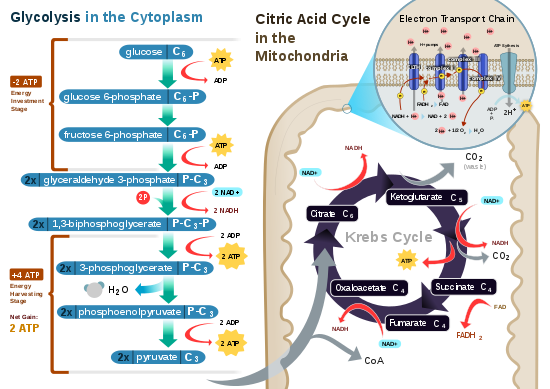
Back تنفس خلوي Arabic Тканкавае дыханне Byelorussian Клетъчно дишане Bulgarian সবাত শ্বসন Bengali/Bangla Analadur Breton Ćelijsko disanje BS Respiració cel·lular Catalan خانە ھەناسە CKB Buněčné dýchání Czech Resbiradaeth cellog Welsh
This article has multiple issues. Please help improve it or discuss these issues on the talk page. (Learn how and when to remove these messages)
|

Cellular respiration is the process by which biological fuels are oxidized in the presence of an inorganic electron acceptor, such as oxygen, to drive the bulk production of adenosine triphosphate (ATP), which contains energy. Cellular respiration may be described as a set of metabolic reactions and processes that take place in the cells of organisms to convert chemical energy from nutrients into ATP, and then release waste products.[1]
Cellular respiration is a vital process that occurs in the cells of all living organisms.[2][better source needed] Respiration can be either aerobic, requiring oxygen, or anaerobic; some organisms can switch between aerobic and anaerobic respiration.[3][better source needed]
The reactions involved in respiration are catabolic reactions, which break large molecules into smaller ones, producing large amounts of energy (ATP). Respiration is one of the key ways a cell releases chemical energy to fuel cellular activity. The overall reaction occurs in a series of biochemical steps, some of which are redox reactions. Although cellular respiration is technically a combustion reaction, it is an unusual one because of the slow, controlled release of energy from the series of reactions.
Nutrients that are commonly used by animal and plant cells in respiration include sugar, amino acids and fatty acids, and the most common oxidizing agent is molecular oxygen (O2). The chemical energy stored in ATP (the bond of its third phosphate group to the rest of the molecule can be broken allowing more stable products to form, thereby releasing energy for use by the cell) can then be used to drive processes requiring energy, including biosynthesis, locomotion or transportation of molecules across cell membranes.
- ^ Bailey, Regina. "Cellular Respiration". Archived from the original on 2012-05-05.
- ^ "Cellular respiration and why it is important - Respiration - AQA Synergy - GCSE Combined Science Revision - AQA Synergy - BBC Bitesize". www.bbc.co.uk. Retrieved 2023-12-07.
- ^ "2.30 Anaerobic and Aerobic Respiration".